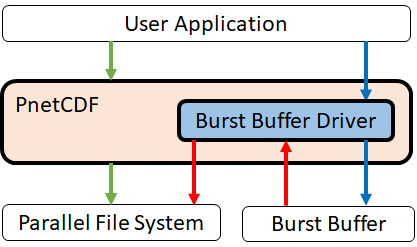

./configure --prefix=/path/to/install --enable-burst-buffering
The remaining steps are the same as usual, to build PnetCDF library, run:
make
To install PnetCDF, run:
make install
MPI_Info_set(info, "nc_burst_buf", "enable");
The hint can also be set using environment variable PNETCDF_HINTS.
export PNETCDF_HINTS="nc_burst_buf=enable"
See more information on how to set PnetCDF hints through the environment variable in the PnetCDF C Interface Guide.
| Hint Key | Value | Default Value | Description |
|---|---|---|---|
| nc_burst_buf | enable or disable | disable | Whether to enable Burst Buffer Driver or not. The rest of the hints will be ignored if Burst Buffer Driver is disabled. |
| nc_burst_buf_dirname | a directory name | (see description) | The location on burst buffer system to store I/O data. Take Cori at
NERSC as example. It is usually set to the value of variable DW_JOB_PRIVATE or DW_JOB_STRIPED, depending on the access_mode set in the batch script.
See the user guide of How to use the Burst Buffer on Cori for picking the access mode. If nc_burst_buf_dirname is not set by the user, PnetCDF will display a warning and set it to the same directory of the NetCDF file. |
| nc_burst_buf_del_on_close | enable or disable | enable | Whether the intermediate files created by the Burst Buffer Driver on the burst buffer should be deleted after closing the NetCDF file. If the job schedular will recycle the burst buffer space automatically, users can disable this option to improve performance. |
| nc_burst_buf_flush_buffer_size | an integer in bytes | 0 | Amount of memory in each MPI process that allows PnetCDF to use for flushing the data stored in the burst buffer to the parallel file system. 0 means unlimited. Note that this value must any single write request that is larger than the buffer size will not be buffered. Instead, it will be written to the parallel file system directly, bypassing the burst buffer. |
More example programs can be found under example/burst_buffer folder.
#include<stdio.h>
#include<stdlib.h>
#include<pnetcdf.h>
int main(int argc, char *argv[]){
int ncid, err;
MPI_Info info;
MPI_Info_create(&info);
/* Enable the Burst Buffer Driver.
* The hint is not required if it is set in the environment variable PNETCDF_HINTS
*/
MPI_Info_set(info, "nc_burst_buf", "enable");
/* Create a NetCDF file with hint to enable Burst Buffer Driver*/
ncmpi_create(MPI_COMM_WORLD, filename, NC_CLOBBER, info, &ncid);
MPI_Info_free(&info);
/* For doing other IO operations, the code is the same as usual
* No actions required after file creation
*/
/* Data stored in the burst buffer will be flushed automatically to the PFS when the file is closed */
mpi_close(ncid);
return 0
}
Here is an example command of requesting a burst buffer space in sm_pool with stripe count at least 64.
#DW jobdw capacity=1289GiB access_mode=private type=scratch
For more information, please refer to "How to use the Burst Buffer" and "Performance Tuning" page on NERSC website.
Here's an example of setting the stripe count to 64 and stripe size to 8 MiB on current working directory that is using Lustre on Cori:
lfs setstripe -c 64 -s 8m .
For more information, please refer to "Optimizing I/O performance on the Lustre file system" page on NERSC website and "Configuring Lustre File Striping" on Lustre wiki site.
#!/bin/bash
#SBATCH -p debug
#SBATCH -N 1
#SBATCH -C haswell
#SBATCH -t 00:01:00
#SBATCH -o burst buffer_FLASH_example.txt
#SBATCH -L scratch
#DW jobdw capacity=1289GiB access_mode=private
NNodes=${SLURM_NNODES}
NProc=NNodes*32
export PNETCDF_HINTS="nc_burst_buf=enable;nc_burst_buf_del_on_close=disable;nc_burst_buf_dirname=${DW_JOB_PRIVATE}"
srun -n ${NProc} ./flash_benchmark_io ${SCRATCH}/flash_
Q: Can I run the Burst Buffer Driver on a different machine with a different burst buffer configuration?
A: We currently have only tested the Burst Buffer Driver on Cori at NERSC and the Cray
burst buffer system installed there.
It may also work on other burst buffer implementations where the burst buffer is mounted as a file system.
Q: Can I run the Burst Buffer Driver without the burst buffer?
A: Yes, as long as the hint "nc_burst_buf_dirname" is a valid directory, PnetCDF will use it as a burst buffer.
However, the performance will be affected depending on the performance of the devices.
Q: Do I need to enable DataWarp module on Cori to build PnetCDF with Burst
Buffer Driver support?
A: No, we currently do not use DataWarp APIs in the implementation.
Q: Can I leave the data on burst buffer without flushing it to the parallel
file system?
A: No, in this version, the data will always be flushed when the file is
closed. We do not recommand terminating the program without closing the file.
Q: What is the file name of intermediate files Burst Buffer Driver used to buffer
I/O data? Will it overwrite my existing file if there is a name conflict?
A:
The intermediate files are named as <NetCDF file name>_<ncid>_<rank>.meta and
<NetCDF file name>_<ncid>_<rank>.data. To prevent overwriting other files by
accident, Burst Buffer Driver will not proceed when there is a file name conflict.
In such case,
ncmpi_create
and
ncmpi_open will fail with error code NC_EEXISTS.
Q: Does the directory used by burst buffer to store I/O data need to be an empty folder?
A: No, there's no such restriction. However, we strongly recommend the use of
an empty folder to prevent errors caused by file name conflict.
Q: Is there a way to trigger a flush without closing the NetCDF file?
A: Yes, calling
ncmpi_sync triggers a flsuh. A flush can also be triggered if the user
waits on a non-blocking write request that is still buffered on burst buffer.
git clone https://github.com/Parallel-NetCDF/PnetCDF.git
Initialize autoconf utility settings using command:
autoreconf -i
Next, run configure command to build the PnetCDF library.
For more information about running configure commands, readers are referred to the README files under folder
doc.